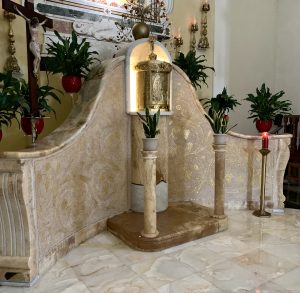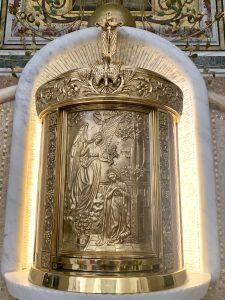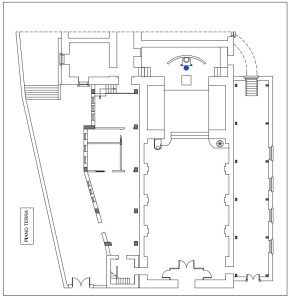Tabernacolo e basamento marmoreo





Parrocchia Santuario Maria SS. di Carpignano
Tabernacolo sec. XX
Basamento marmoreo sec. XXI
Egidio Iovanna
Bronzo dorato e marmi policromi

Parish Sanctuary Maria SS. di Carpignano
Tabernacle XX century
Marble base XXI century
Egidio Iovanna
Gilded bronze and polychrome marbles
Il Tabernacolo in bronzo dorato e di forma cilindrica, sormontato da una croce, finemente cesellato e dorato, mostra sulla porticina la raffigurazione dell’Annunciazione realizzata a sbalzo.
Fu realizzato nel 1950 e impiantato per la prima volta sull’allora Altare maggiore in occasione della celebrazione dell’ottavo centenario del ritrovamento del quadro. L’incisione di un nome alla base attesta che fu commissionato negli Stati Uniti (USA) e donato da Giovannino Annese, emigrato da Carpignano negli USA.
Durante l’ultimo restauro dell’interno dell’intera chiesa nel 2011, il tabernacolo ha trovato collocazione in una bellissima edicola di marmo bianca, sorretta da una colonna circolare di marmo bianco sovrastata da uno di onice. L’opera, realizzata dall’artista Egidio Iovanna, riprende i motivi e i materiali usati per l’altare e ambone.
Sulla parte di colonna realizzata in onice sono incise tre spighe di grano, dono di Dio, simbolo del lavoro e della fatica umana. Il seme del grano ogni anno muore per rinascere puntualmente a nuova vita, salvando l’uomo dalla morte per fame.
Il chicco di grano è una metafora visibile e concreta: da un lato il suo aspetto inerme e la sua morte apparente, dall’altro la potenza di vegetale racchiusa in esso lo identificano come fonte di vita: morendo, infatti, si moltiplica.
Nella Bibbia molti sono i passi che fanno riferimento al grano, in particolar modo nei Vangeli dove questa pianta addomesticata dall’uomo non è solo dono divino e segno di abbondanza ma diventa, simbolicamente, alimento per l’anima. Il pane ottenuto dal grano diventa il corpo stesso di Cristo e, con il vino, il suo sangue, simbolo eucaristico per eccellenza.
Ad abbellire ulteriormente l’opera, venne realizzata una vela ai due lati dell’intera colonna e nel 2016 fu impreziosita da un mosaico dorato raffigurante tralci di uva e spighe di grano, realizzato dal Maestro d’arte contemporaneo Edmondo Campana.
Sonia Bruno
The Tabernacle in gilded bronze and cylindrical in shape, finely surmounted by a cross, chiseled and gilded, shows on the door the representation of the Annunciation made in overhang.
It was built in 1950 and installed for the first time on the then High Altar in occasion of the celebration of the eighth centenary of the discovery of the painting. The engraving of a name at the base attests that it was commissioned in the United States (USA) and donated by Giovannino Annese, who emigrated from Carpignano to the USA.
During the last restoration of the interior of the entire church in 2011, the tabernacle found a place in a beautiful white marble aedicule, supported by a circular column of white marble topped by one of onyx. The work, created by the artist Egidio Iovanna, takes up the motifs and materials used for the altar and ambo.
On the part of the column made of onyx three ears of wheat are engraved, a gift of God, symbol of work and human fatigue. The wheat seed dies every year to be promptly reborn to new life, saving the man of starvation.
The grain of wheat is a visible and concrete metaphor: on the one hand its helpless appearance and his apparent death, on the other hand the plant power contained in it identify him as a source of life: in dying, in fact, it multiplies.
In the Bible there are many passages that refer to wheat, especially in the Gospels where this plant domesticated by man is not only a divine gift and a sign of abundance but symbolically becomes food for the soul. The bread obtained from the grain becomes the very body of Christ and, with the wine, his blood, the Eucharistic symbol for excellence.
To further embellish the work, a sail was created on both sides of the entire column and in 2016 it was embellished with a golden mosaic depicting grape shoots and ears of grain, created by the contemporary art master Edmondo Campana.
Sonia Bruno
